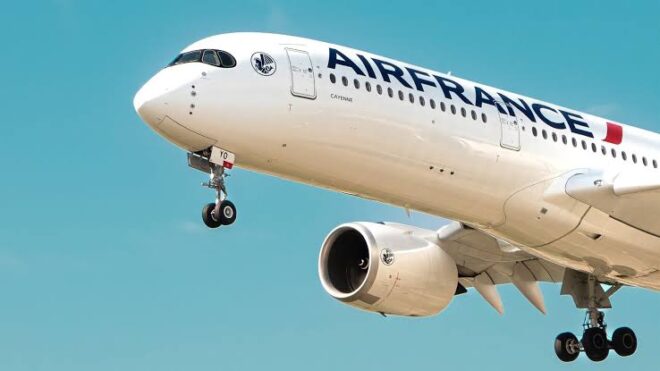
An Air France flight from Paris to Los Angeles made an emergency landing in Canada on Saturday after one of its engines failed during an Atlantic crossing.
The double-deck Airbus A380 aircraft landed safely at Goose Bay Airport on the eastern tip of Canada, according to a statement from Air France. The airline said it suffered “serious damage to one of its four engines.”
“The regularly trained pilots and cabin crew handled this serious incident perfectly,” the airline said in a statement. “The passengers are currently being assisted by teams dispatched to the location.”
Air France Flight 66 departed from the gate at Charles de Gaulle Airport on Saturday, 10:10 a.m. local time, but taxied for more than 90 minutes before eventually departing at 11:42 a.m Paris time, according to FlightAware.
According to Flightradar24, the Airbus A380, the largest passenger jet in the world, encountered the failure while the jet was flying at 37,000 feet near Greenland. The aircraft aborted its Atlantic crossing to Los Angeles and landed there at 12:42 p.m. local time, 11:42 a.m. ET or 15:42 GMT.
Sarah Eamigh, a passenger on the flight, told CNN partner CTV News that passengers sensed something was wrong during the flight.
“We heard a loud pop, and we had a quick descent along with some vibration. It definitely was not turbulence so we knew something was wrong,” she told the Canadian broadcaster.
“The captain was able to recover the plane quite fast, however, we were definitely nervous because the vibrating was probably occurring a good five to eight minutes. And then the captain basically 10 to 15 minutes after provided an announcement stating that we had a small engine explosion.”
Photos from the flight showed the entire front part of the engine, including the large fan and engine’s casing, completely sheared away. The remaining portion of the outermost engine on the right side of the jet was streaked with a brown substance and there were no obvious signs of any external fire.
The missing portion of the front fan generates most of the engine’s thrust, pushing it forward through the air, while the combustion of the fuel and hot components of the engine are farther back.
Engine Alliance, which is the engine manufacturer for the A380 involved in the incident, said in a statement that it is “working with authorities to assess the situation” and would defer to investigating authorities for future information as is protocol for aviation safety inquiries.
Engine Alliance is a joint venture between engine makers General Electric and Pratt & Whitney.
Any crossing of an ocean, pole or even large deserted area, no matter the number of engines, involves precautions to always have a place to divert in case of an emergency. Flight-planners take into account airports that are open and have good weather across different points along the crossing, and dispatchers and pilots closely calculate the nearest places to land should such an accident occur.
But such an engine failure, like the one aboard Air France 66, is incredibly rare and even more so during the cruise phase of a long-distance flight.
In 2010, a Qantas Airbus A380 suffered a major failure of one of its engines shortly after takeoff from Singapore, forcing the crew to troubleshoot a cascading series of failures as a result of the damage the engine’s explosion caused to the jet. The aircraft landed safely. That jet used a different type of engine than the one in Saturday’s incident.
Stranded passengers
The airline has sent two aircraft to take the 497 passengers who were on the enormous jetliner onward to Los Angeles.
Goose Bay, a small town in eastern Canada, isn’t accustomed to handling enormous jetliners like the A380. While it may have a runway long enough to act as a safe place to divert, the airport might not immediately be able to marshal the resources to handle a large aircraft once it’s on the ground.
Passenger Nathan Goldberg told CNN over the phone that people on the plane were calm for the most part, but disappointed in the lack of communication from the airline.
Several hours after the plane landed, passengers said they remained onboard.
“We’ve been sitting on this plane since this morning waiting to take off. It’s frustrating because we’re not getting information,” he said.
He said the crew on board were working diligently to take care of the passengers. The in-flight entertainment system and air conditioning have remained on, and they have food and water.
“The flight attendants have been fantastic and very helpful, but for whatever reason, they haven’t provided a lot of information because I don’t think they know themselves,” he said.
Air France said the two flights that will ferry the passengers are scheduled to leave Goose Bay early Sunday.